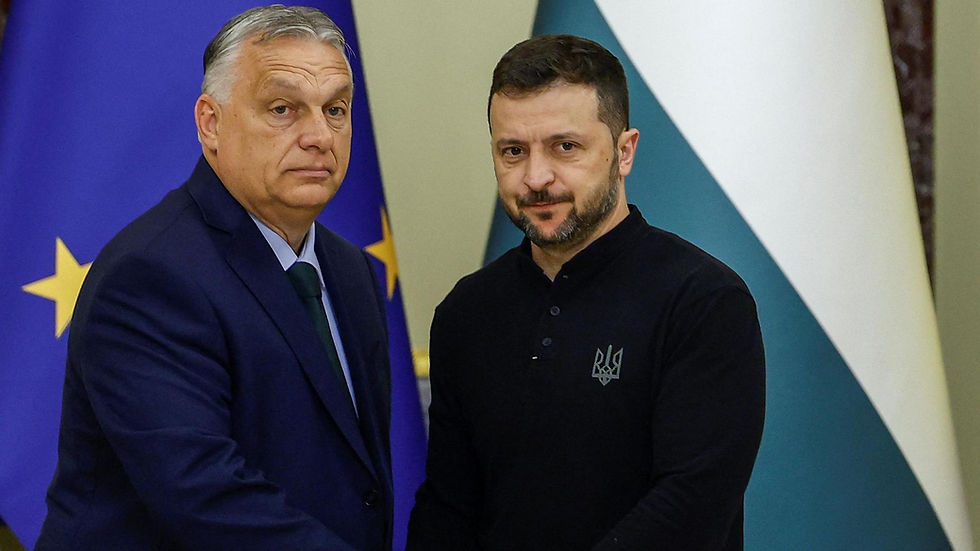Ukraine and Hungary: Imagining a War That Neither Side Wants
- Matthew Parish
- Sep 28
- 3 min read

When President Volodymyr Zelenskyy warned recently that Russia may yet seek to drag other European states into her war, speculation arose in some quarters about what that might mean for Ukraine’s immediate neighbours. Amongst them, Hungary stands out. She has cultivated unusually warm ties with Moscow, she quarrels frequently with Kyiv over the Hungarian minority in Zakarpattia, and she has become a persistent thorn in the side of the European Union’s attempts to maintain unity against Russia.
But could this tense relationship ever escalate into open armed conflict? And if so, what would be the likely outcomes?
History’s shadow: Trianon and Zakarpattia
Hungary’s grievances are rooted deep in the twentieth century. The Treaty of Trianon (1920) stripped her of two-thirds of her territory, including Transcarpathia. Today’s Zakarpattia region of western Ukraine still houses a Hungarian-speaking minority. Budapest is vocal in their defence, complaining that Ukraine’s education and language laws sideline their rights.
“Orbán plays to a domestic audience that sees Trianon as an open wound,” says a senior Central European diplomat, “but Kyiv regards this as meddling during an existential war for survival.”
For Hungary, then, the issue has symbolic power. For Ukraine it is a distraction, and at times a dangerous one.
Orbán’s Moscow connection
What heightens suspicion is Viktor Orbán’s cordiality with Vladimir Putin. While most of Europe has turned away from Russian gas and oil, Budapest still buys. In Brussels, Hungary has watered down sanctions packages and delayed EU funding tranches for Kyiv. In NATO, Budapest has objected to closer integration with Ukraine.
From Moscow’s perspective, Hungary is a useful irritant inside Western institutions. For Kyiv, she is a spoiler. Yet none of this equates to a readiness to fire shots across the Carpathians.
A yawning military imbalance
The cold military facts make the prospect of a war absurd.
Ukraine fields perhaps 700,000 to 900,000 men and women under arms, hardened by years of battle. Her artillery, drones, and air-defence systems are amongst the most extensive in Europe. Despite attrition, her skies are guarded by a mix of Soviet aircraft and Western Patriots, IRIS-Ts and NASAMS. Her long-range drones have even struck deep inside Russia.
Hungary, by contrast, has a professional army of about 30,000. Her tank fleet — under 150 Leopards — and her dozen leased Swedish Gripen fighters, are modern but small. Orbán has launched a “Zrínyi 2026” modernisation plan for military expansion, but Hungary’s force structure is designed for defence at home, not expeditionary adventures abroad.
“It is not a serious comparison,” remarks a NATO analyst in Warsaw. “Ukraine’s army is larger than that of France or Germany. Hungary’s is closer in size to Luxembourg’s.”
NATO’s shield
Hungary’s NATO membership changes the equation in another way. An unprovoked Ukrainian strike on Hungarian soil would trigger Article 5 collective defence and turn Ukraine’s survival war into an unwinnable two-front catastrophe. Kyiv knows this.
Equally, if Hungary contrived an incident, the alliance would face a credibility test. Article 5 presumes a member is under attack, not the instigator. Other allies would hesitate to fight Ukraine on Budapest’s behalf. This makes reckless Hungarian adventurism improbable.
Scenarios of friction
Still, there are a few pathways by which violence could creep in:
Minority unrest in Zakarpattia, stirred by Budapest or by Moscow, might lead to local clashes.
Cross-border incidents from smuggling, refugees, or over-zealous border guards could spark gunfire.
False-flag provocations staged by Russia could be designed to implicate Hungary, distracting Ukraine and dividing NATO.
None of these, however, are likely to escalate into conventional war.
The costs of fantasy war
Were a genuine conflict to erupt, both sides would be ruined. Ukraine would lose Western solidarity, and Hungary would find herself isolated in Europe, cut off from EU funds, strangled by sanctions, and mocked as Moscow’s puppet. Russia would be the only winner.
As one European Commission official put it recently: “Orbán plays games, but not games that end with tanks rolling across borders. He needs EU money too much.”
Conclusion: politics, not war
Thus the prospect of Ukraine and Hungary at war is a mirage. Historical grievances and minority disputes make headlines, but they are insufficient to ignite a real conflict. The military imbalance makes the idea ludicrous. NATO’s legal structures make it suicidal.
The real battlefield will remain political. It will be fought in Brussels, where Hungary uses her veto to frustrate; in NATO councils, where Budapest drags her feet; and in Zakarpattia’s schools, where questions of language and identity continue to play out.
To imagine otherwise is to accept Russia’s narrative of division. And that is precisely what Europe cannot afford.




